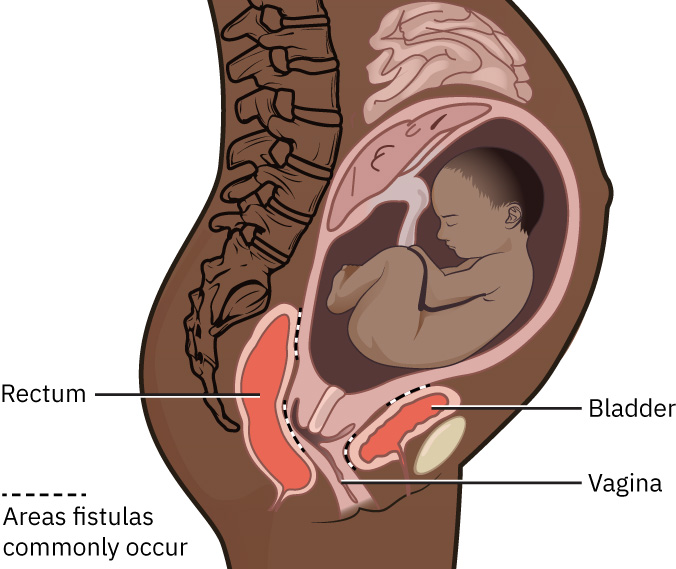18.12 Fistulas
A fistula is an abnormal connection between two body parts, such as between the rectum and the vagina or the bladder and the vagina, often resulting from injury, surgery, or infection. The most common cause of fistulas is obstetrical trauma that occurs during childbirth, operative vaginal deliveries (e.g., the use of vacuum or forceps), or episiotomy or laceration repair. Figure 18.10[1] shows the common areas where fistulas form. There are several types of fistulas that may occur in the reproductive system, including the following[2]:
- A vaginal fistula is an opening from the vagina to another anatomical structure.
- A rectovaginal fistula is an opening from the rectum to the vagina.
- A vesicovaginal fistula is an opening between the bladder and the vagina.
- A urethrovaginal fistula is an opening between the urethra and the vagina.

Signs and symptoms of reproductive fistulas include leakage of urine or stool from the vagina, frequent urinary and vaginal infections, or a foul odor. Very small fistulas may heal on their own, but most will require surgical repair.[3]
- “a93a9d585f9fc46c7f5158efba825d702111b06f” by Rice University/Open Stax is licensed under CC BY 4.0. https://openstax.org/books/maternal-newborn-nursing/pages/6-2-structural-disorders ↵
- Giles, A., Prusinski, R., & Wallace, L. (2024). Maternal-newborn nursing. OpenStax. https://openstax.org/books/maternal-newborn-nursing/pages/1-introduction ↵
- Giles, A., Prusinski, R., & Wallace, L. (2024). Maternal-newborn nursing. OpenStax. https://openstax.org/books/maternal-newborn-nursing/pages/1-introduction ↵
An abnormal connection between two body parts, such as between the rectum and vagina or the bladder and vagina, often resulting from injury, surgery, or infection.
An opening from the vagina to another anatomical structure.
An opening from the rectum to the vagina.
An opening between the bladder and the vagina.
An opening between the urethra and the vagina.

